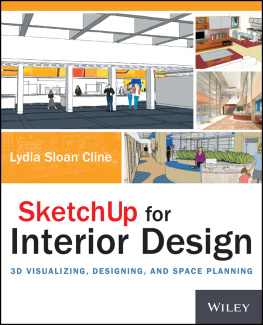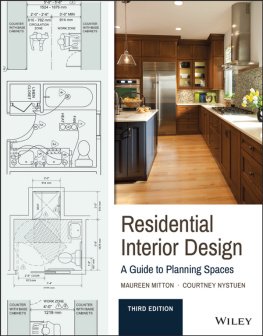
BUILDING SYSTEMS FOR INTERIOR DESIGNERS
THIRD EDITION
Corky Binggeli, ASID
This book is printed on acid-free paper. 
Copyright 2016 by John Wiley & Sons, Inc. All rights reserved.
Published by John Wiley & Sons, Inc., Hoboken, New Jersey.
Published simultaneously in Canada.
No part of this publication may be reproduced, stored in a retrieval system, or transmitted in any form or by any means, electronic, mechanical, photocopying, recording, scanning, or otherwise, except as permitted under Section 107 or 108 of the 1976 United States Copyright Act, without either the prior written permission of the Publisher, or authorization through payment of the appropriate per-copy fee to the Copyright Clearance Center, 222 Rosewood Drive, Danvers, MA 01923, (978) 7508400, fax (978) 6468600, or on the web at www.copyright.com. Requests to the Publisher for permission should be addressed to the Permissions Department, John Wiley & Sons, Inc., 111 River Street, Hoboken, NJ 07030, (201) 7486011, fax (201) 7486008, or online at www.wiley.com/go/permissions.
Limit of Liability/Disclaimer of Warranty: While the publisher and author have used their best efforts in preparing this book, they make no representations or warranties with the respect to the accuracy or completeness of the contents of this book and specifically disclaim any implied warranties of merchantability or fitness for a particular purpose. No warranty may be created or extended by sales representatives or written sales materials. The advice and strategies contained herein may not be suitable for your situation. You should consult with a professional where appropriate. Neither the publisher nor the author shall be liable for damages arising herefrom.
For general information about our other products and services, please contact our Customer Care Department within the United States at (800) 7622974, outside the United States at (317) 5723993 or fax (317) 5724002.
Wiley publishes in a variety of print and electronic formats and by print-on-demand. Some material included with standard print versions of this book may not be included in e-books or in print-on-demand. If this book refers to media such as a CD or DVD that is not included in the version you purchased, you may download this material at http://booksupport.wiley.com. For more information about Wiley products, visit www.wiley.com.
Cover image: Matejay/iStockphoto
Cover design: Wiley
Library of Congress Cataloging-in-Publication Data:
Binggeli, Corky, author.
Building systems for interior designers / Corky Binggeli.Third edition.
pages cm
Includes bibliographical references and index.
ISBN 978-1-118-92554-6 (hardback)
ISBN 978-1-118-92555-3 (ePub)ISBN 978-1-118-92556-0 (Adobe PDF)ISBN 978-1-118-92554-6 (hardback) 1. BuildingsEnvironmental engineering. 2. BuildingsMechanical equipmentDesign and construction. 3. BuildingsElectric equipment--Design and construction. I. Title.
TH6014.B56 2016
696dc23
2015031808
Preface
The first edition of Building Systems for Interior Environments arose from my need for a textbook to use in teaching interior design students that gave them the understanding and skills to work with architects and engineers. This third edition of Building Systems for Interior Environments updates the role of interior designers as part of the building design team, and addresses their special needs for information on todays building system design and equipment.
Interior designers today work closely with other design and construction professions to provide functional, sustainable, and healthy buildings. Sophisticated digital control systems permit design that supports varied occupancy and work styles and schedules. This results in more individualized control of the interior environment, which is conducive to worker satisfaction and productivity.
Sustainable design supports a holistic approach to building systems, where the older territorial distinctions between the various building system and architectural/engineering disciplines are opening up. Existing buildings are being adapted and reused for new purposes. The impact of energy efficiency and water conservation in buildings is widely recognized. This third edition of Building Systems for Interior Environments reflects these changes.
In addition, the third edition benefits from the comments of experienced educators as to the best ways to organize and focus the information. The updated contents are arranged to flow smoothly in an order that facilitates the teaching process.
Part I looks at environmental conditions and the site, the building envelope and the building design process, sustainable design, the interaction of the human body with the built environment, and how building codes protect us. Part II addresses building forms, structures, and elements including floor/ceiling assemblies, walls, stairs, windows, and doors. Part III introduces acoustic design principles and architectural acoustics. Part IV addresses water supply, waste, and reuse systems, as well as plumbing fixtures and appliances. Part V covers principles of thermal control, indoor air quality, ventilation, and moisture control, and heating and cooling. Part VI explains electrical system basics and electrical distribution, as well as lighting systems. Part VII concludes the book with coverage of fire safety design, conveyance systems, and communications, security, and control equipment.
More than 40 percent of the third editions text is new. This edition contains over 485 illustrations, approximately 260 of which are new and 160 redrawn or revised. There are also over 175 tables, 125 of which are new or significantly revised. References to related materials in other chapters are included. Tips indicating material of assistance and interest to interior designers are also included. Key terms are defined in the text and indicated in bold. Quotations from architectural and engineering sources aid in understanding the perspective of other design professionals.
Interior designers need to understand the viewpoints and respect the expertise of other design professionals. Building Systems for Interior Designers provides the information they need to do this, without delving into engineering calculations. It focuses on the parts of the building design process that most affect the occupants functional needs, and provides a technical but readily understandable foundation for the design of interior spaces. Residential as well as commercial and institutional spaces are included.
Building Systems for Interior Designers is listed by the National Council for Interior Design Qualification (NCIDQ) as a reference for preparation for the NCIDQ exam. The third edition is supplemented by online materials including an Instructors Manual with knowledge areas, topics for discussion, and definitions of key terms, PowerPoint presentations for each chapter, and a Test Bank with sample questions. Supplemental material is available at www.wiley.com/go/bsid3e.
Corky Binggeli, ASID
Arlington, MA
Acknowledgements
The authorship of a book involves a great amount of solitary work and persistence. Turning the manuscript and illustrations into a published book involves the efforts of many others. I have now published seven booksplus second and third editions of some of themwith the team at John Wiley & Sons, and I want to thank them once again for their professionalism, support, and good advice.
Next page












